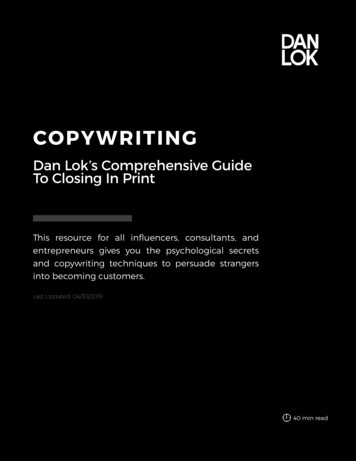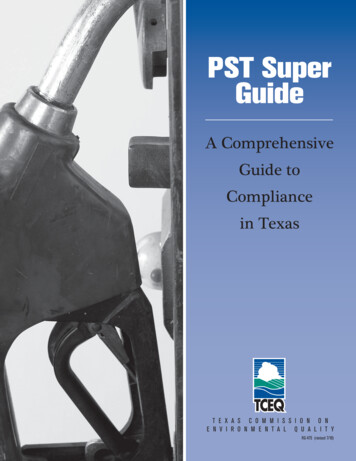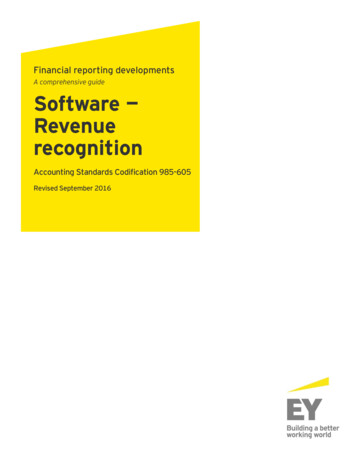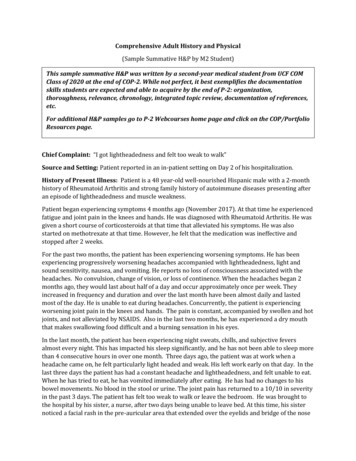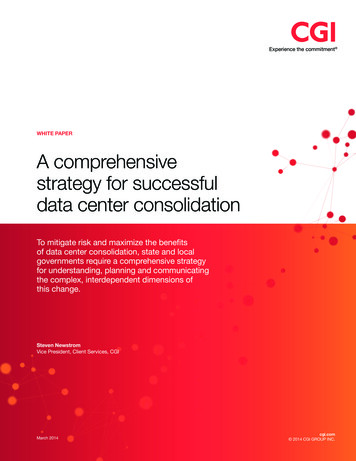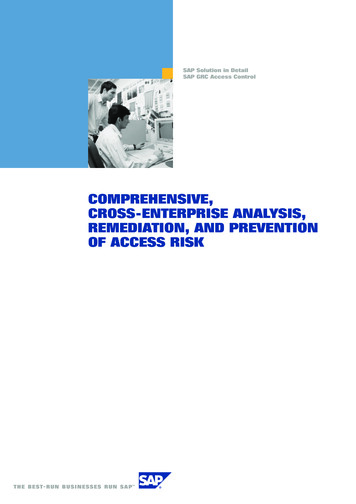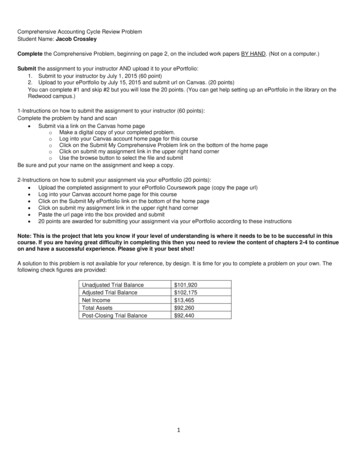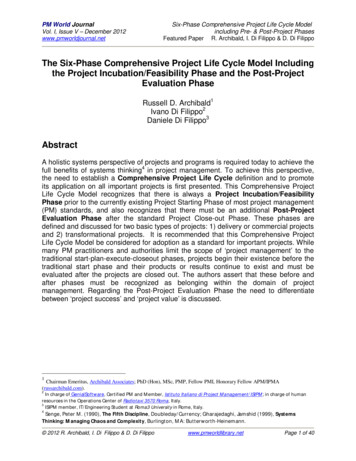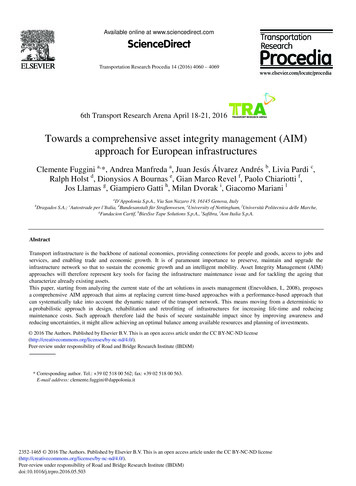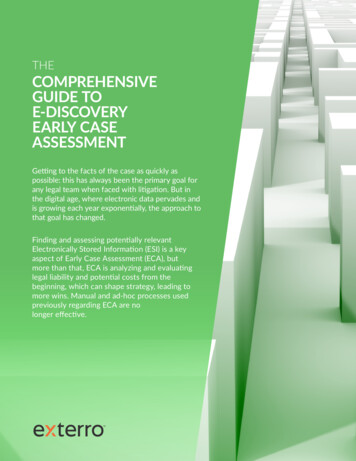
Transcription
THECOMPREHENSIVEGUIDE TOE-DISCOVERYEARLY CASEASSESSMENTGetting to the facts of the case as quickly aspossible: this has always been the primary goal forany legal team when faced with litigation. But inthe digital age, where electronic data pervades andis growing each year exponentially, the approach tothat goal has changed.Finding and assessing potentially relevantElectronically Stored Information (ESI) is a keyaspect of Early Case Assessment (ECA), butmore than that, ECA is analyzing and evaluatinglegal liability and potential costs from thebeginning, which can shape strategy, leading tomore wins. Manual and ad-hoc processes usedpreviously regarding ECA are nolonger effective.
THE GUIDE,IN BRIEFIn this comprehensiveearly case assessment(ECA) guide relating toe-discovery activities,learn how to incorporateECA (and/or early dataassessment (EDA))principles and toolsinto your legal process,enabling your legal teamto make strategic casedecisions earlier in thee-discovery process.ContentsCHAPTER 1What is ECA, exactly? . . . . . . . . . . . . . . . . . . 4CHAPTER 2What does ECA Involve? . . . . . . . . . . . . . . . . 5CHAPTER 3Understanding the Importance of ECAunder Updated FRCP . . . . . . . . . . . . . . . . . . 7CHAPTER 3 DEEPER DIVE8 Tips for Making an EffectiveProportionality Argument . . . . . . . . . . . . . . 9CHAPTER 4Targeted Collections:Key for Improving Your ECA Strategy . . . . . . . . 10CHAPTER 5Technology Features Needed in Your ECA Toolkit . 13CHAPTER 6Review: ECA Best Practices . . . . . . . . . . . . . 16CONCLUSION . . . . . . . . . . . . . . . . . . . . . . 18APPENDIXEarly Case Assessment Checklist . . . . . . . . . . . 19Custodian Interview Questionnaire . . . . . . . . . 20 2017 Exterro, Inc. exterro.com // info@exterro.com // 1 (503) 501-5102
BEFORE WE GET STARTED, PONDER THIS:Organizations Struggle To Effectively SearchBig Data Volumes, Creating An Uphill BattleWhen Conducting ECAExterro asked 208 in-house legal and ITprofessionals involved in E-Discovery:“What is your biggest obstacle in locatingpotentially responsive data?”Searching through largeamounts of data39%Identifying/accessingdata sources for collection35%Developing search criteria fordetermining document relevancy15%Using in-house e-discovery search/collection software effectively8%Working with 3rd party collection/processing providers3%0%20%40%Findings from this recent Exterro survey highlighted above indicate that legal teams face dauntingroadblocks for conducting ECA “early” in the e-discovery process. Some explanations on whysearching and developing search criteria is so challenging from a few survey respondents:AttorneyParalegalIT"My organization still has alarge amount of data in hardcopy form that is located in anumber of offices throughoutour service territory. There isa high risk of us not findingresponsive documents simplyb/c we don't know they exist.""It takes a lot of time and moneyto review lots of documents, sohaving a good search criteriacan minimize the documentsyou have to review by returningmostly potentially responsivedocuments and less miss hits.”"Sometimes what an attorneyis looking for isn’t alwaystranslatable into search terms,or they need help definingwhat they’re looking for." 2017 Exterro, Inc. exterro.com // info@exterro.com // 1 (503) 501-5103
CHAPTER 1What is ECA, exactly?Ask ten e-discovery professionalsto describe early case assessmentand you're likely to get ten differentanswers. Unlike other e-discoveryprocesses, like preservation, collection,and review (all of which center onspecific sets of actions), ECA is amuch more dynamic process whichcan involve a number of differentapproaches and strategies that changefrom case to case.ECA DefinedECA is the process of attempting to quicklysurface the key intelligence which will ultimatelyguide case strategy early on in a legal matter.An effective ECA strategy seeks answers toquestions such as: What are the key issues in the legal matter? What keywords and search terms are relevant to those issues? How much potentially relevant data doI have? What are the potential e-discovery costsrelated to the complaint? What is my overall legal liability? Are there any key documents that must beaccounted for?When you have answers to these questions, it'smuch easier to determine whether to seek anearly settlement, proceed to trial, or attempt toadjust e-discovery parameters so they are lesscostly and burdensome.It's important to note that ECA is much morethan simply examining potentially relevantelectronically stored information (ESI), which issometimes referred to as Early Data Assessment(EDA). ECA is a comprehensive evaluation oflegal liability and potential costs at the outsetof a case. In addition to looking at the relevantdata, ECA will include comparing mattersagainst similar past matters, deciding aboutwhat counsel to retain, and looking at previouscourt rulings to assess the viability of a matter.Seeing as this is an e-discovery guide, weare going to focus on the data elementsof ECA. Keep in mind, e-discovery coststypically consume by far the biggest chunkof the litigation budget. Thus, e-discoveryconsiderations figure very prominently into theoverall ECA equation.ECA is a Cross-EDRM ProcessYou'll notice that ECA is not recognized as an actual stage in the Electronic DiscoveryReference Model (EDRM). That's because ECA usually spans multiple e-discoverystages and includes both process-centric (left side of and data-centric (right side ofEDRM) activities. Another way to think about it is that ECA activities run concurrentto other e-discovery processes, such as identification, preservation, and collection. 2017 Exterro, Inc. exterro.com // info@exterro.com // 1 (503) 501-5104
CHAPTER 2What does ECA Involve?It's one thing to determine that acase is "big” which will involve a lot ofdata and custodians, and will surelycost a lot of money. Most lawyerscan make that assessment just bylooking at the basic facts of the legalmatter. But It's another thing entirelyto attach real figures and data tothose projections. The more precisethe estimates, the more confidentlyyou can set the right litigation course.So, how do you get there? There area variety of things that go into aneffective ECA process, including:CustodianInterviewsCommunicating directly with custodians(employees in possession of potentially relevantESI) is a good way to get an idea of matterscope. Interviews help you determine who isinvolved in the legal matter, where and howmuch data is involved, and whether there areany especially important documents like asmoking gun that could ultimately swing thelitigation one way or the other. You likely won'tcome away from custodian interviews with anyhard numbers, but you should have a greatstarting point from which to proceed to a moredetailed analysis.DataAnalyticsA major component of ECA, data analytics isthe process of turning raw data (think thousandsof documents) into useful information. It goeswithout saying that legal teams don't have theluxury to go through every single documentwhile formulating their case strategy. Instead,they can utilize data analytics to generate reportswhich capture data volumes, custodian names,date ranges, email domains, key concepts, andother insights into large data sets. Analytics canserve a quantitative function (how much stuff isout there?) as well as a qualitative one (is there a 2017 Exterro, Inc. exterro.com // info@exterro.com // 1 (503) 501-5105
II. WHAT DOES ECA INVOLVE?CHAPTER #Titlesmoking gun?). The data analysis and reports canbe used by counsel to make informed decisionsregarding the best course of action.DataSamplingAnother way you can analyze large data setsis through data sampling. The whole conceptof data sampling is pretty straight forward. Itassumes that by examining a representativesubset of documents, you are able to drawaccurate conclusions about the entire datapopulation. In the context of e-discovery, thattranslates to examining a small set of documentsfor relevancy in order to determine how manyrelevant documents might exist across theentire data corpus. Data sampling is loaded withminutiae when you start getting into samplesizes, confidence rates, and margins of error.And this isn't a math class. What's important toremember is that when done effectively, datasampling can be a very effective e-discoverytool, as noted by several industry experts andorganizations, including EDRM.ReportingReports are a critical ECA component, becausethey help you make sense of everything. Throughreports and dashboards, you can more easilydigest key figures, trends, and other actionableinformation. For example, a report might revealthat e-discovery costs and burdens far outweighthe monetary value of the case, a fact that mighthave been missed looking at the data at a moregranular level. Plus, reports are export-friendlyand easy to share with a judge or opposing party.Reports also keep a historical record of activitiesin case something needs to be revisited long afterthe fact. 2017 Exterro, Inc. exterro.com // info@exterro.com // 1 (503) 501-5106
CHAPTER 3Understanding the Importance ofECA under Updated FRCPIn some way, every legal team willconduct ECA. As we noted above,everyone does not practice ECA in thesame way. For those with undefinede-discovery practices and/or don’thave access to e-discovery searchtechnology, their ECA practices mayonly involve conducting custodianinterviews. For those with moreadvanced search technology, their ECApractices might involve data samplingand other data analytics to identify thenecessary facts and metrics to pivotcase strategy.But a shift may be occurring. Therecent e-discovery amendmentsto Rule 26, specifically around theproportionality principle, may enticeand even require more legal teams tostart incorporating advanced searchtechnologies to determine proportionale-discovery terms.Proportionality is certainly not a new conceptin e-discovery. If you aren't familiar with theproportionality rule, it essentially dictatesthat the value of requested ESI must beproportionate to the resources required forretrieving it (Rule 26(b)(1)). After years ofattorneys and judges ignoring or not leveragingproportionality, the recent 2015 Federal Rulesof Civil Procedure (FRCP) amendments havehighlighted the rule and its importance incomplying with FRCP Rule 1, whose objective is“the just, speedy and inexpensive determinationof every action and proceeding.”“While the concept of proportionalityexisted in Rule 26 for some time in theformer Rule 26(b)(2) (c)(iii), it has arguablybeen overshadowed by the “reasonablycalculated to lead to the discovery ofadmissible evidence” language which wasremoved with the 2015 amendments.This language was often utilized tosupport requests for wide open, andexpensive, discovery. The revised language'crystalizes the concept of reasonablelimits on discovery through increasedreliance on the common sense conceptof proportionality” and has, accordingto the survey, had the largest effect one-discovery practices. Almost 60% of thejudges surveyed recognized Rule 26(b)(1)as the most impactful of the amendments.'Carolyn SutherlandManaging DirectorMorae LegalAs a result, judges and attorneys appear tobe embracing proportionality—or at leastdiscussing it—more now than ever before.According to Exterro’s 3rd Annual FederalJudges Report, 77% of judges surveyed saidthat applying principles of cooperation andproportionality offers the greatest potential forimprovement from counsel. And to leverageproportionality, legal teams must start adjustingwhat their ECA practices entail.SEE NEXT PAGE FOR COMPARISON OF THE OLD RULE 26(B)(1) WITH THE NEW RULE 2017 Exterro, Inc. exterro.com // info@exterro.com // 1 (503) 501-5107
CHAPTER 3 SUPPLEMENTRULE 26(b)(1)Old RuleComparision of theOld Rule 26(b)(1)with the New RuleNew RuleSummaryParties may obtain evidence regardingany non-privileged matter that is relevantto any party’s claim or defense, includinginformation that may lead to admissibleevidence.Rule in FullUnless otherwise limited by court order, thescope of discovery is as follows: Parties mayobtain discovery regarding any nonprivilegedmatter that is relevant to any party’s claim ordefense—including the existence, description,nature, custody, condition, and location ofany documents or other tangible things andthe identity and location of persons whoknow of any discoverable matter. For goodcause, the court may order discovery ofany matter relevant to the subject matterinvolved in the action. Relevant informationneed not be admissible at the trial if thediscovery appears reasonably calculated tolead to the discovery of admissible evidence.All discovery is subject to the limitationsimposed by Rule 26(b)(2)(C).Implications of this RuleEnables requesting party to cast an expansivenet for potentially responsive ESI, leading toincreased e-discovery costs for preservation,collection, and review.SummaryParties may obtain evidence regarding to anynon-privileged matter that is relevant andproportional to any party’s claim or defense.Rule in FullUnless otherwise limited by court order, thescope of discovery is as follows: Parties mayobtain discovery regarding any non-privilegedmatter that is relevant to any party’s claimor defense and proportional to the needs ofthe case, considering the importance of theissues at stake in the action, the amount incontroversy, the parties’ relative access torelevant information, the parties’ resources,the importance of the discovery in resolvingthe issues, and whether the burden orexpense of the proposed discovery outweighsits likely benefit. Information within thisscope of discovery need not be admissible inevidence to be discoverable.SEE NEXT PAGE TO LEARN HOW TOUSE ECA PRINCIPLES FOR MAKING ANEFFECTIVE PROPORTIONALITY CLAIMUNDER RULE 26(B)(1) 2017 Exterro, Inc. exterro.com // info@exterro.com // 1 (503) 501-5108
III. UNDERSTANDING THE IMPORTANCEOF ECA UNDER UPDATED FRCPCHAPTER #CHAPTER 3 DEEPER DIVETitle8Tips for Making an EffectiveProportionality ArgumentFeaturingMaura GrossmanResearch ProfessorUniversity of WaterlooHon. Joy ContiChief District JudgeWestern District of Pennsylvania1. Defining the Scope of Discovery. Thefocus of this rule is not just about relevancy.For information to be within the scopeof discovery, the information needs to berelevant and proportional. This narrowing ofwhat is discoverable should greatlyaffect your ECA practices for determiningwhat e-discovery parameters to propose,and if your opponent fits within thesenew parameters.2. Proof of Proportionality. Both therequesting and responding parties havethe burden to prove that their e-discoveryparameters are proportional. If you decideto make a proportionality argument to thecourt, be sure to have metrics to back upyour claim.3. No More Discovery about Discovery.This is very significant based on what wasdeleted from the old rule: (“reasonablycalculated to lead to the discovery ofadmissible evidence”). As a result, courtsmay stop parties from allowing discoveryabout discovery requests.4. Have Metrics Readily Available.Grossman: “If you’re the client, starttracking! Find out what it costs to produceper custodian, or per gig of data, or toproduce from a mobile device. It’s hard forsomeone to argue with you when you showthem cold hard numbers.”5. Review Each Proportionality Factorin Concrete. Judge Conti: “You needto know the details about what makes itrelevant, where your strong arguments are,and where your weak arguments are.Then you can better show the court ifyou’re proportional.”6. Leverage Technology Now. Grossman:“The volume of ESI is not going down. Andwhile we may not be to the point where theuse of technology is mandatory, it won’t belong before it is.”7. Make it Easy for the Judge to Rulefor You. Whenever you present aproportionality argument to a judge, makesure to give the judge the necessarycontext and background to understand whye-discovery terms are unduly burdensome.Judge Conti says: “It is important thatyou tell the judge what can work insteadof what won’t work when it comes toproportionality.”8. Present Alternative Remedies.Judge Conti: “If you don’t present alternativeremedies, then the judge may say, ‘I don’thave any other choice.’ But if you canoffer another solution for getting theinformation that is relevant to the matter ina more cost effective way, then you have amuch better chance.” 2017 Exterro, Inc. exterro.com // info@exterro.com // 1 (503) 501-5109
CHAPTER 4Targeted Collections: Key forImproving Your ECA StrategyAll too often, parties adopt thedefensive position of casting a widecollection net to alleviate the riskof something important gettingoverlooked. This approach leadsto an over-gathering of data frommany custodians and data sources.Factoring in the costs associated withoutsourcing collection, processing, andstorage of the data to a vendor (whichmany organizations do), it can take asubstantial amount of time and moneyto find the 1% of the informationneeded to resolve the matter.More and more legal teams are implementingways to get to the facts of the case soonerby updating their collection strategies via atargeted collection approach. An approachsuch as this involves applying technologyand procedures to reduce the volume of ESIdatasets collected. This approach is part of alarger defensible data reduction strategy whosegoal is eliminating all documents from reviewthat will not be ultimately used to resolve thematter. With attorney review representing70% – 80% of the overall cost of e-discovery,taking a more targeted approach to collectionswill substantially reduce these costs, as well asthose associated with data hosting, processing,and production (e.g., load file creation). Moreimportantly, targeted collection reduces thechance of inadvertent production of privilegedESI and the costs associated with retrieving it.Here are some key components ofa targeted collection strategy:Develop an AirtightPreservation ProcessThere are different methods forpreserving ESI, and a defensiblepreservation model rarely relies onjust one. The legal hold process representsthe first line of preservation defensibility. Ata minimum, organizations should have welldefined processes that automate legal holdmanagement, communication with custodians,hold escalation, and enforcement.Implicit in a defensible hold process isconsistently and effectively addressing “highpriority” custodians—those that, for a varietyof reasons, have ESI that merits immediateprotection. This typically involves key playerswhose ESI is unquestionably highly relevant tothe issues of the matter, may have an incentiveto destroy or hide certain information, or whohave left (or are likely to leave) the companyunder a cloud. In these circumstances, it’susually advisable to preserve these custodians’ 2017 Exterro, Inc. exterro.com // info@exterro.com // 1 (503) 501-51010
IV. ADVANCED SEARCH TECHNIQUES:KEY FOR IMPROVING YOUR ECA STRATEGYESI. Newer technologies allow this practiceto be done in-place so that invisible copiesare made to a separate server to eliminatespoliation risk. The other option is an immediatecollection of that vulnerable ESI; however,this assumes the device is available locally.Collections via a network tend to be timeconsuming and rely on the custodians beingconnected. The key is to have an establishedprocess for making these determinations, so theresponse isn’t haphazard and inconsistent fromone matter to the next.Gather IntelligenceBefore CollectionSometimes, thinking of thee-discovery process as a seriesof sequential phases can get in the way ofidentifying key facts and understanding theoverall legal posture. The more that is knownabout the case early on, the better the result.To that end, no collection effort shouldproceed w
When you have answers to these questions, it's much easier to determine whether to seek an early settlement, proceed to trial, or attempt to adjust e-discovery parameters so they are less costly and burdensome. It's important to note that ECA is much more than simply examining potentially r

